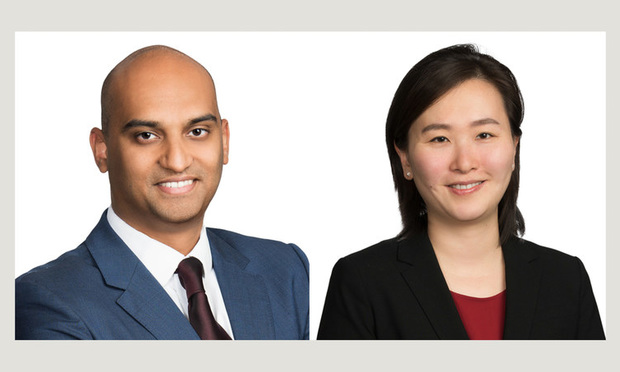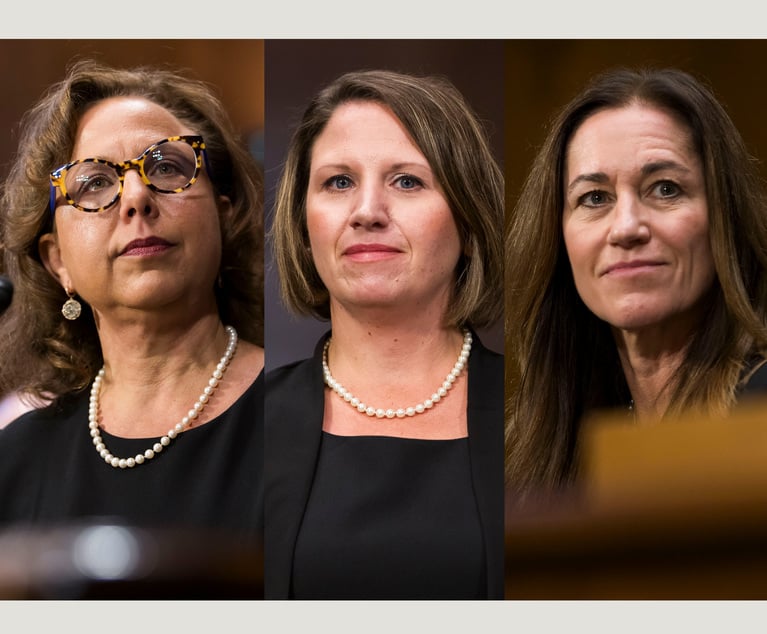Infringement Issues in Artificial Intelligence Patents
Artificial intelligence (AI), also referred to as machine-learning technology, refers to software that applies data to incrementally improve its functionality and output.
March 29, 2019 at 03:32 PM
8 minute read
 Ameya V. Paradkar and Ji Young Park of Blank Rome
Ameya V. Paradkar and Ji Young Park of Blank Rome
Technological Background
Artificial intelligence (AI), also referred to as machine-learning technology, refers to software that applies data to incrementally improve its functionality and output. From a layperson's perspective, the term, AI, may elicit images of a super-intelligent computer, but in fact, it affects many aspects of everyday lives, often without our awareness. Whether receiving a recommendation on a new streaming show or asking a digital assistant for a weather forecast, AI technology forms the basis of the algorithms that ensure that the user receives accurate, relevant information.
AI technologies are designed and implemented in software. What makes AI different from more traditional software is that the coded algorithm of the software “learns,” improving its efficiency and accuracy based on its compilation and analysis of data. Thus, while an AI technology may reach an acceptable competency after being fed an initial training set of data, a user will generally start to see optimum software performance with greater and more varied data input that occurs through additional iterations of the algorithm.
Because AI algorithms engage in iterative learning, the software may begin performing additional steps not contemplated by the software creator as it optimizes performance. For example, an algorithm that is coded to analyze data in one particular manner may begin to perform additional analyses that it finds useful. Certain AI algorithms may even write themselves subroutines that formally incorporate such analyses into the program. By integrating those new routines, the AI software becomes more efficient at performing its tasks.
Claims Directed to AI Present Novel Issues in Infringement
The iterative learning capabilities of AI technology introduce a number of issues related to patent infringement. Typically, software is claimed in patents as a series of method steps. AI technology, as a type of software, is usually provided to customers through a Service as a Software (“SaaS”) service model, in which the provider hosts the software on its servers, while providing customers a subscription for its use. It may infringe a patent directed to the same technology under two legal theories: direct infringement and indirect infringement. Direct infringement occurs where the provider of AI technology directly practices the steps of the method claimed by a patent. Indirect infringement occurs where the provider itself does not directly practice the method, yet still provides the AI technology for others to practice. Separate legal requirements must be satisfied to find infringement under each of the two theories, with each of the requirements raising issues that are particular to AI technology offered as SaaS and impacting how effectively AI technology can be protected under current patent law.
In general, to show direct infringement, it is preferable to demonstrate that a single entity performs all of the steps of a method claim. When that is not possible, however, if the software provider performs the steps of the AI algorithm in conjunction with its customers, the provider itself may be liable for patent infringement in method claims based on the theory of divided infringement. Under that theory, “an entity responsible other's performance of a part of the patented invention” will be held liable for directly infringement patent even if itself is not performing the entire scope of the patent that includes the steps of both installing and executing the AI software “where that entity directs or controls others' performance,” as in Akamai Technologies v. Limelight Networks, 797 F.3d 1020, 1022 (Fed. Cir. 2015) (en banc). For example, where a provider of AI technology installs the AI software on its cloud environment for the customer to execute on-demand, the AI software is practiced by two entities: the provider and its customer. Despite there being two entities practicing the AI software, the patentee can successfully bring a patent infringement claim only against the provider under Akamai's theory of liability.
The Akamai “control and direction” analysis is a fact-specific inquiry, where “liability for infringement can be found when an alleged infringer conditions participation in an activity or receipt of a benefit upon performance of a step or steps of a patented method and establishes the manner or timing of that performance.” A number of factors are considered, including the signing of a standard contract, a welcome letter, instructions for use, assignment of user identifiers, installation guides, and provisioning of technical assistance. And given that a typical AI SaaS provider instructs the customer of an AI software to follow the steps of executing the software to reap the benefits of the AI technology, while providing technical assistance followed by use guidelines, an AI software provider may squarely meet the requirements of divided infringement, thereby unwittingly subjecting itself to a claim of direct patent infringement.
A second theory under which a AI technology provider may incur liability is for indirect infringement. Unlike direct infringement, where infringement is found as long as there is a performance of a patented technology, indirect infringement requires that an alleged infringer knew of the disputed patent, knew that the induced acts infringed, and intended to bring about the infringement, as in Commil USA v. Cisco Systems, 135 S. Ct. 1920, 1925, 1928 (2015). This, in turn, requires that the patentee plead facts plausibly showing that the alleged infringer specifically intended its customers to infringe the disputed patent and knew that the customers' acts constituted infringement, see In re Bill of Lading Transmission & Processing Systems Patent Litigation, 681 F.3d 1323, 1339 (Fed. Cir. 2012).
The “knowledge” and “intent” requirements articulated by the courts, however, raise a thorny issue for AI technologies. AI technology may morph into software performing steps that infringe a claimed method after the initial sale of the software and following a customer's continued use. Even if the AI software provider knew that its AI software might later embody an infringing feature at the point-of-sale, the mere knowledge of possible infringement is not sufficient to satisfy the “knowledge” and “intent” requirement of indirect infringement, as in Vita-Mix v. Basic Holding, 581 F.3d 1317, 1328 (Fed. Cir. 2009). The scienter standard for indirect infringement is particularly demanding because the law is reluctant to find liability when a defendant merely sells a commercial product suitable for some lawful use that infringes a patent after the sales,a s in DSU Medical v. JMS Co., 471 F.3d 1293, 1305 (Fed. Cir. 2006) (en banc).
The current posture on direct and indirect infringement highlights several concerns for patentees and defendants. Based on the current state of the law, it is prudent for a patentee asserting claims directed to AI technology to ensure that method claims target the activities of a single entity. If that is not possible, the entity should at least be able to assert direct infringement under divided infringement theory, rather than navigating the challenges of demonstrating indirect infringement. Especially considering that software providers generally provide their software through the SaaS model, it is critical to include steps or features performed or controlled by a SaaS provider to be able to bring a patent infringement suit against the SaaS provider. These steps or features may include installing specific software on a cloud server environment or provisioning hardware or software resources based upon the customer's execution of the software. Furthermore, it is important to ensure that all steps in the method claim are controlled or directed by the SaaS provider, ideally reciting what steps the SaaS server controls in the execution of the AI software.
Conversely, it is in an accused infringer's advantage to identify method steps that are performed by the customer, outside its control, to demonstrate non-infringement, even under a divided infringement theory. A step such as providing an ad-hoc input to the software, generally performed by a user, may qualify as an action that is not controlled by the accused infringer. Moreover, because AI technologies may be designed to integrate additional methods as they learn, SaaS providers that distribute AI software should remain vigilant, maintaining a real-time mapping of the AI algorithm and subroutines to ensure that the software is not performing unexpected data analyses that may subject the provider to infringement claims.
Ameya V. Paradkar is an associate at Blank Rome. He concentrates his practice on patent litigation and counseling in software related to authentication, data streaming and artificial intelligence, as well as biotechnology. He can be reached at [email protected].
Ji Young Park is also an associate at the firm. She concentrates her practice on patent litigation and counseling in telecommunication standards, networking systems and artificial intelligence. She also advises on data protection and cybersecurity issues. She can be reached at [email protected].
This content has been archived. It is available through our partners, LexisNexis® and Bloomberg Law.
To view this content, please continue to their sites.
Not a Lexis Subscriber?
Subscribe Now
Not a Bloomberg Law Subscriber?
Subscribe Now
NOT FOR REPRINT
© 2025 ALM Global, LLC, All Rights Reserved. Request academic re-use from www.copyright.com. All other uses, submit a request to [email protected]. For more information visit Asset & Logo Licensing.
You Might Like
View All
Pa. Federal District Courts Reach Full Complement Following Latest Confirmation

The Defense Bar Is Feeling the Strain: Busy Med Mal Trial Schedules Might Be Phila.'s 'New Normal'
7 minute read
Federal Judge Allows Elderly Woman's Consumer Protection Suit to Proceed Against Citizens Bank
5 minute read
Judge Leaves Statute of Limitations Question in Injury Crash Suit for a Jury
4 minute readTrending Stories
- 1Uber Files RICO Suit Against Plaintiff-Side Firms Alleging Fraudulent Injury Claims
- 2The Law Firm Disrupted: Scrutinizing the Elephant More Than the Mouse
- 3Inherent Diminished Value Damages Unavailable to 3rd-Party Claimants, Court Says
- 4Pa. Defense Firm Sued by Client Over Ex-Eagles Player's $43.5M Med Mal Win
- 5Losses Mount at Morris Manning, but Departing Ex-Chair Stays Bullish About His Old Firm's Future
Who Got The Work
J. Brugh Lower of Gibbons has entered an appearance for industrial equipment supplier Devco Corporation in a pending trademark infringement lawsuit. The suit, accusing the defendant of selling knock-off Graco products, was filed Dec. 18 in New Jersey District Court by Rivkin Radler on behalf of Graco Inc. and Graco Minnesota. The case, assigned to U.S. District Judge Zahid N. Quraishi, is 3:24-cv-11294, Graco Inc. et al v. Devco Corporation.
Who Got The Work
Rebecca Maller-Stein and Kent A. Yalowitz of Arnold & Porter Kaye Scholer have entered their appearances for Hanaco Venture Capital and its executives, Lior Prosor and David Frankel, in a pending securities lawsuit. The action, filed on Dec. 24 in New York Southern District Court by Zell, Aron & Co. on behalf of Goldeneye Advisors, accuses the defendants of negligently and fraudulently managing the plaintiff's $1 million investment. The case, assigned to U.S. District Judge Vernon S. Broderick, is 1:24-cv-09918, Goldeneye Advisors, LLC v. Hanaco Venture Capital, Ltd. et al.
Who Got The Work
Attorneys from A&O Shearman has stepped in as defense counsel for Toronto-Dominion Bank and other defendants in a pending securities class action. The suit, filed Dec. 11 in New York Southern District Court by Bleichmar Fonti & Auld, accuses the defendants of concealing the bank's 'pervasive' deficiencies in regards to its compliance with the Bank Secrecy Act and the quality of its anti-money laundering controls. The case, assigned to U.S. District Judge Arun Subramanian, is 1:24-cv-09445, Gonzalez v. The Toronto-Dominion Bank et al.
Who Got The Work
Crown Castle International, a Pennsylvania company providing shared communications infrastructure, has turned to Luke D. Wolf of Gordon Rees Scully Mansukhani to fend off a pending breach-of-contract lawsuit. The court action, filed Nov. 25 in Michigan Eastern District Court by Hooper Hathaway PC on behalf of The Town Residences LLC, accuses Crown Castle of failing to transfer approximately $30,000 in utility payments from T-Mobile in breach of a roof-top lease and assignment agreement. The case, assigned to U.S. District Judge Susan K. Declercq, is 2:24-cv-13131, The Town Residences LLC v. T-Mobile US, Inc. et al.
Who Got The Work
Wilfred P. Coronato and Daniel M. Schwartz of McCarter & English have stepped in as defense counsel to Electrolux Home Products Inc. in a pending product liability lawsuit. The court action, filed Nov. 26 in New York Eastern District Court by Poulos Lopiccolo PC and Nagel Rice LLP on behalf of David Stern, alleges that the defendant's refrigerators’ drawers and shelving repeatedly break and fall apart within months after purchase. The case, assigned to U.S. District Judge Joan M. Azrack, is 2:24-cv-08204, Stern v. Electrolux Home Products, Inc.
Featured Firms
Law Offices of Gary Martin Hays & Associates, P.C.
(470) 294-1674
Law Offices of Mark E. Salomone
(857) 444-6468
Smith & Hassler
(713) 739-1250





